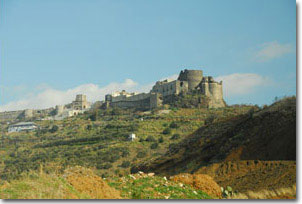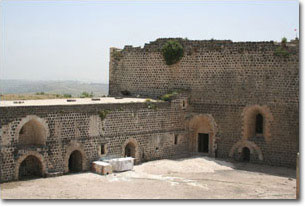|
About
40 km south of Lattakia; at the foot of the mountain, Baniyas has a
much longer history than the castle on the mountain (al-Marqab), dating
its foundation to the Phoenicians and may have played the defensive
role later assumed by the massive castle. It was used by the Greeks, Romans and Byzantines and became the seat of
the bishop. The Crusaders installed themselves first in Banyas which
they knew as Valenie. Qalaat Marqab (Marqab Castle):  About 10 km south of Baniyas; located at the point where the plain
narrows to a precarious passage between the sea and the mountains,
Marqab is in many ways the most baleful of the Crusaders fortresses; or
at least the most somber. About 10 km south of Baniyas; located at the point where the plain
narrows to a precarious passage between the sea and the mountains,
Marqab is in many ways the most baleful of the Crusaders fortresses; or
at least the most somber.
The site is the natural location for a fortified post but it does not
seem to have been used for this purpose until the Muslims built there
in 1062. The Crusader presence quickly faded away and it was the Byzantine who
took the site of Marqab from the Arabs in an expedition of 1104. The
site of Marqab returned to the Principality of Antioch at some stage
among 1108 - 1140. Later, it was sold to the Knights Hospitable around 1186. Marqab
avoided the fate of other castles still held in private hands which
lacked the resources to withstand Saladin's raid. Following the victory
over the Crusaders in Hattin, Saladin marched past the fortress of
Marqab in his sweep up the coast in 1188 but did not attack it. 
By 1271, its status had already been eroded when, following the fall of
the Krakow to Baybars, the Mamelukes of Cairo enforced and agreement
for a sharing of the revenues of Marqab's dependant lands between the
Hospitable and the Sultan. It was besieged, bombarded and undermined by
Baybars and his successor, Qalaun in 1285. The fortress surrendered a
month after. With the fall of Tripoli in 1289 and Tartous in 1291, the
ethos which had sustained such gigantic ambitions ended. Qalaun the Mameluke retained the fortress and he and his Arab
successors strengthened some of its defenses, including the south
tower. It remained in military hands until Ottoman times but it ended
up as a repository for discredited former governors. The Towers The south tower of the first enclosure wall echoes the great donjon
tower above. A band of white marble runs around the upper part of the
outer wall. This typically Arab or rather Mameluke stylistic flourish
carries and Arabic inscription dating from Qalaun's reconstruction of
the south defenses. The east tower was built at the same time as the donjon. The tower gave
flanking protection to the south eastern corner and guarded the small
postern gate leading to the circuit walk above the first enclosure
wall. The Bridge (to the gate)  The Arab bridge, leading up to the west gate of the 13th century, is covered with gradually rising stairs that runs in 90° turn
over the ditch and into the entrance gateway looking out over the
Mediterranean. The Arab bridge, leading up to the west gate of the 13th century, is covered with gradually rising stairs that runs in 90° turn
over the ditch and into the entrance gateway looking out over the
Mediterranean.
The Barbican Gate To
the north is the Barbican Gate that dates from 1270. It is a
cross-vaulted chamber that leads to stairs and an archway into the main
courtyard of the keep. The Chapel Aligned east/west, its main entrance is on the west side with a side
door to the north. It dates from the initial phase of the Hospitable
control (end of 12th century) ad is a gem of austere Crusader
architecture. The beautiful doorways on the northern and western sides
are similar in their rich moldings and elegant colonnades. The interior
is divided into two bays by the cross-groined vaulting. The absence of
internal columns adds a feeling of space in what is a relatively small
structure, typically of the striving for openness and light in the
Gothic period. At the east end of the chapel is the rounded apse that
is raised two steps above the level of the rest of the chapel. |


